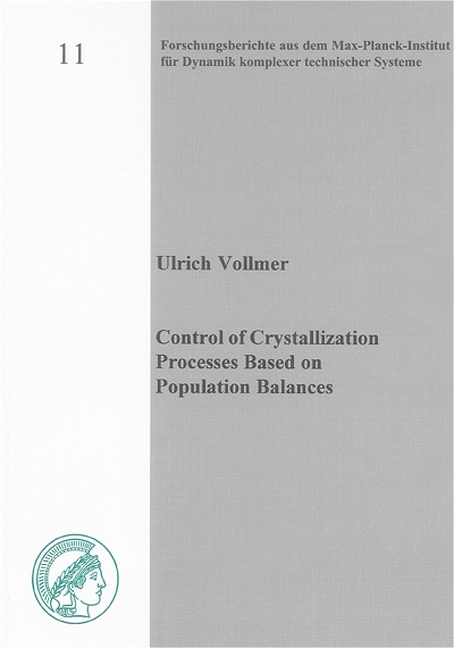
Control of Crystallization Processes Based on Population Balances
Seiten
2005
|
1., Aufl.
Shaker (Verlag)
978-3-8322-4317-3 (ISBN)
Shaker (Verlag)
978-3-8322-4317-3 (ISBN)
- Keine Verlagsinformationen verfügbar
- Artikel merken
In this dissertation, population balance models describing crystallization processes are used as a basis for the design of control strategies. Crystallization processes are used in the chemical and pharmaceutical industry for the production of solid materials. In the following only crystallization from solution is considered. Crystallization is frequently used because in many cases chemical reactions take place in liquid phase whereas products often are solid materials. Furthermore, crystallization can be used for purification and separation.
The basic concept of crystallization is simple and well known. A solution can be supersaturated, e.g. by cooling or by evaporation of solvent. In a supersaturated solution, solute molecules from the solution are built into the crystal lattice. Hence, the crystal is growing. Furthermore, new crystals can emerge from the solution. Consequently, solute mass is transfered from liquid solution to solid crystals. Supersaturation is the driving force for these processes. The most significant property of crystals is their size. Crystal size distribution (CSD) is the crucial variable in industrial crystallizers. This is, on the one hand, due to the fact that the dynamics of crystallization plants can only be understood when regarding the CSD. On the other hand, the CSD is important because it heavily influences product quality and down-stream processability. It influences properties such as filterability, the ability to flow or the dissolution rate of crystalline material.
Industrial crystallization plants can be operated in basically two different ways: continuous or batch. These two modes of operation result in two different control problems, which are both addressed in this dissertation. Therefore, the thesis is composed of two major parts corresponding to the two fundamentally different control problems arising in crystallization. It is the aim of this work to demonstrate that sophisticated up-to-date control synthesis methods can be applied to crystallization processes on the basis of population balance models.
The basic concept of crystallization is simple and well known. A solution can be supersaturated, e.g. by cooling or by evaporation of solvent. In a supersaturated solution, solute molecules from the solution are built into the crystal lattice. Hence, the crystal is growing. Furthermore, new crystals can emerge from the solution. Consequently, solute mass is transfered from liquid solution to solid crystals. Supersaturation is the driving force for these processes. The most significant property of crystals is their size. Crystal size distribution (CSD) is the crucial variable in industrial crystallizers. This is, on the one hand, due to the fact that the dynamics of crystallization plants can only be understood when regarding the CSD. On the other hand, the CSD is important because it heavily influences product quality and down-stream processability. It influences properties such as filterability, the ability to flow or the dissolution rate of crystalline material.
Industrial crystallization plants can be operated in basically two different ways: continuous or batch. These two modes of operation result in two different control problems, which are both addressed in this dissertation. Therefore, the thesis is composed of two major parts corresponding to the two fundamentally different control problems arising in crystallization. It is the aim of this work to demonstrate that sophisticated up-to-date control synthesis methods can be applied to crystallization processes on the basis of population balance models.
| Reihe/Serie | Forschungsberichte aus dem Max-Planck-Institut für Dynamik komplexer technischer Systeme ; 11 |
|---|---|
| Sprache | englisch |
| Maße | 148 x 210 mm |
| Gewicht | 221 g |
| Einbandart | Paperback |
| Themenwelt | Technik ► Elektrotechnik / Energietechnik |
| Schlagworte | HC/Technik/Elektronik, Elektrotechnik, Nachrichtentechnik • Kristallisation • Populationsbilanzen • Regelungstechnik • Verfahrenstechnik • Verteilte Systeme |
| ISBN-10 | 3-8322-4317-8 / 3832243178 |
| ISBN-13 | 978-3-8322-4317-3 / 9783832243173 |
| Zustand | Neuware |
| Haben Sie eine Frage zum Produkt? |
Mehr entdecken
aus dem Bereich
aus dem Bereich
Kolbenmaschinen - Strömungsmaschinen - Kraftwerke
Buch | Hardcover (2023)
Hanser (Verlag)
49,99 €


